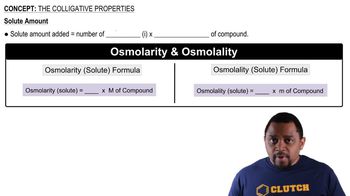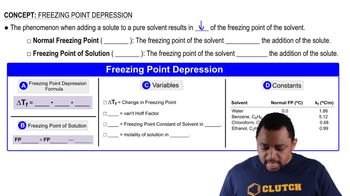Here are the essential concepts you must grasp in order to answer the question correctly.
Colligative Properties
Colligative properties are physical properties of solutions that depend on the number of solute particles in a given amount of solvent, rather than the identity of the solute. These properties include boiling point elevation and freezing point depression, which are crucial for determining how the presence of a solute like ethylene glycol affects the freezing and boiling points of water.
Recommended video:
Freezing Point Depression
Freezing point depression is a colligative property that describes the lowering of the freezing point of a solvent when a solute is added. The extent of this depression can be calculated using the formula ΔTf = i * Kf * m, where ΔTf is the change in freezing point, Kf is the freezing point depression constant of the solvent, and m is the molality of the solution.
Recommended video:
Freezing Point Depression
Boiling Point Elevation
Boiling point elevation is another colligative property that indicates the increase in the boiling point of a solvent when a solute is dissolved in it. This can be calculated using the formula ΔTb = i * Kb * m, where ΔTb is the change in boiling point, Kb is the boiling point elevation constant of the solvent, and m is the molality of the solution. Understanding this concept is essential for determining how the boiling point of water changes in the presence of ethylene glycol.
Recommended video:

 Verified step by step guidance
Verified step by step guidance

